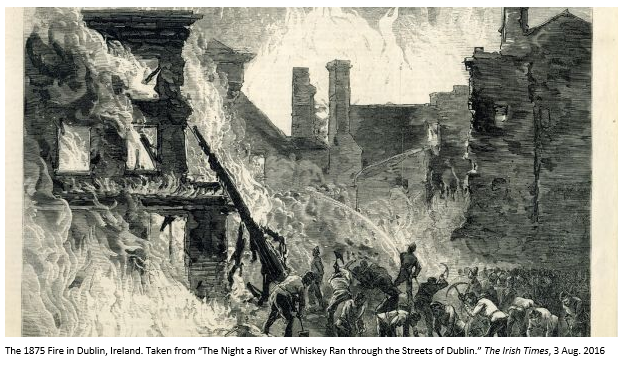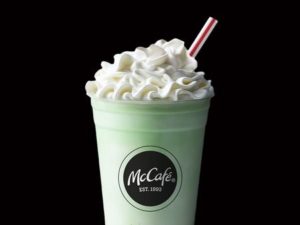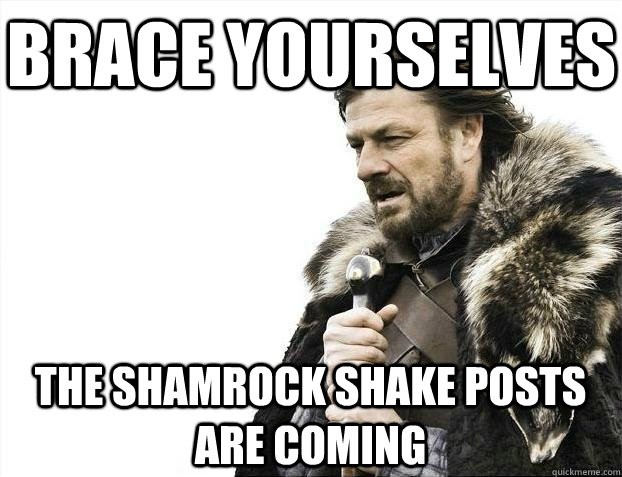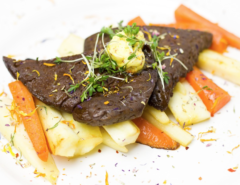BY: MEGAN KESLER

Imagine for a moment, that the year is 1875 and you are living in the great city of Dublin, Ireland. Except on this particular day in June, the city is not so great because it’s on fire. This is not your typical fire either, because this one is flowing through the streets like a river. You hear people screaming and see panicked animals running in every direction as the fire continues to spread. Then, you see something rather odd. The man next to you takes off his boot, bends over, scoops up some of the fiery river with the boot, and drinks it in a single gulp. Why would he do this? How is it even possible? Turns out, the blazing liquid flowing through the streets of Dublin that day was actually good ‘ole Irish Whiskey, pouring out from the 5,000 burst whiskey barrels at Malone’s Malt House & Storehouse, where the fire started. In the wake of the devastating fire, The Irish Times reported that “caps, porringers, and other vessels were in great requisition to scoop up the liquor as it flowed from the burning premises, and disgusting as it may seem, some fellows were observed to take off their boots and use them as drinking cups” [8].
Here in the U.S. we endulge in drinking Irish Whiskey, savoring each sip as well, particularly on March 17th when 60% of Americans celebrate St. Patrick’s Day by donning green, eating corned beef and cabbage, and of course, drinking Irish beer and whiskey.

In order that you may impress your foodie friends this St. Paddy’s Day, here are four foods/beverages to know more about:
- Shamrock Shakes®
 The McDonald’s Shamrock Shake® is a minty milkshake that is dyed green to look like a shamrock – the symbol of St. Patrick. The much-anticipated dessert, which is available every year for a limited time near St. Paddy’s day, was introduced in 1970 as “St. Patrick’s Day Shake”. Since then, over 60 million Shamrock Shakes® have been sold [5]. The shake consists of three delicious parts: vanilla ice cream, flavored syrup, and whipped cream. For the major food geeks, here’s the full list of ingredients from the McDonald’s website [9]:
The McDonald’s Shamrock Shake® is a minty milkshake that is dyed green to look like a shamrock – the symbol of St. Patrick. The much-anticipated dessert, which is available every year for a limited time near St. Paddy’s day, was introduced in 1970 as “St. Patrick’s Day Shake”. Since then, over 60 million Shamrock Shakes® have been sold [5]. The shake consists of three delicious parts: vanilla ice cream, flavored syrup, and whipped cream. For the major food geeks, here’s the full list of ingredients from the McDonald’s website [9]:
VANILLA REDUCED FAT ICE CREAM
Ingredients: Milk, Sugar, Cream, Corn Syrup, Natural Flavor, Mono and Diglycerides, Cellulose Gum, Guar Gum, Carrageenan, Vitamin A Palmitate.
Contains: MILK.
SHAMROCK SHAKE SYRUP
Ingredients: High Fructose Corn Syrup, Corn Syrup, Water, Sugar, Natural Flavor, Xanthan Gum, Citric Acid, Sodium Benzoate (Preservative), Yellow 5, Blue 1. May contain small amounts of other shake flavors served at the restaurant, including egg ingredients when Egg Nog Shakes are available.
WHIPPED LIGHT CREAM
Ingredients: Cream, Nonfat Milk, Liquid Sugar, Contains 2% or Less: Mono and Diglycerides, Natural Flavors, Carrageenan. Whipping Propellant (Nitrous Oxide).
Contains: MILK.

While the Shamrock Shake® may not actually have anything to do with being Irish, there’s no doubt that it has become an iconic symbol of St. Patrick’s Day. If you, like me, can’t wait to get your hands on one in just a few short weeks, check out the Shamrock Shake® Finder in the McDonald’s app.
- Soda bread
Irish soda bread is a quick bread traditionally enjoyed throughout the year in Ireland. Although not invented by the Irish, soda bread became popular in the country around the time of the potato famine because it required only a few, inexpensive ingredients and was easy to make [1]. A high protein wheat, known as hard or strong wheat, is typically used to make conventionally baked bread that we are used to. When bread dough made with hard flour is kneaded, the gluten forms a protein network that is capable of trapping small air bubbles, such as those produced by yeast during fermentation. The air bubbles trapped in the protein network cause the bread to rise, giving it a light and airy texture. Bread leavened with yeast must be left to rest for 30-60 minutes before baking to give the yeast time to produce enough CO2 gas to cause the dough to rise. In contrast, soda bread is made with soft wheat flour that is low in gluten. Since there is not a protein network that can trap gas as it is slowly produced by yeast, soda bread is not leavened by yeast fermentation. Rather, soda bread is chemically leavened with baking soda, hence the name. Baking soda reacts with moisture to rapidly produce carbon dioxide, which expands the dough. However, the dough must be baked soon after adding baking soda so that the gas is not lost and the bread remains airy. Because a resting step is not necessary for chemically leavened breads, they can be made in a short period of time and are consequently called “quick” breads. In addition to flour and baking soda, Irish soda bread is made with salt and buttermilk. If raisins are added, the bread is called “Spotted Dog”.

Different styles of soda bread are made in various regions of Ireland. In Northern Ireland, farl style soda bread is made by rolling the dough into a disk, cutting it into four pieces, and cooking it on a griddle or in a frying pan. In Southern Ireland, cake style soda bread is made by shaping the dough into a round form, cutting an “X” on top to allow steam to escape while cooking, and baking in the oven. Whether farl or cake style, the characteristic cross on top of the bread is said to ward off evil spirits.
If you’ve never had soda bread, why not try baking up a loaf or two this St. Paddy’s day? Bonus points for being trendy if you serve it with cultured Irish butter. Yum!
- Guinness® beer
 Another must-have on St. Patrick’s Day is a Guinness® beer. The most famous Irish beer gets its name from its founding brewer Arthur Guinness. Arthur began brewing ale in 1752 in Leixlip, Ireland. In 1759, Arthur moved to Dublin and set up shop in an unused brewery, which he obtained by signing a 9,000-year lease [3]. No, that is not a typo, Arthur really did sign a lease that spanned 9 millenia. Clearly, he had faith in the success of his product, and rightly so. Today Guinness® is valued at $4.1 billion and holds the 8th spot for largest brand value of beers worldwide [2].
Another must-have on St. Patrick’s Day is a Guinness® beer. The most famous Irish beer gets its name from its founding brewer Arthur Guinness. Arthur began brewing ale in 1752 in Leixlip, Ireland. In 1759, Arthur moved to Dublin and set up shop in an unused brewery, which he obtained by signing a 9,000-year lease [3]. No, that is not a typo, Arthur really did sign a lease that spanned 9 millenia. Clearly, he had faith in the success of his product, and rightly so. Today Guinness® is valued at $4.1 billion and holds the 8th spot for largest brand value of beers worldwide [2].
Here are some fast facts about our favorite Irish beer from the Guinness® website [4]:
- Guinness® is a dry stout made from water, roasted malted barley, hops, and yeast
- Recommended serving temperature is 6-7⸰C
- There are 198 calories in 1 pint of Guinness®
- Guinness Draught is 4.2% alcohol by volume
- The famous creamy head is produced using a mixture of nitrogen and CO2
- The black color come from the dark roast of the malt
- When you drink a Guinness®, you are drinking mountain water, sourced from the Wicklow mountains that lie just south of Dublin
- Irish Whiskey
Did you know that Irish whiskey, Scotch, Bourbon, Tennessee whiskey, Rye, and Canadian whiskey are all types of whiskey? Maybe you did, in which case you may want to skip to the conclusion. But for those of us who are not whiskey connoisseurs, what is Irish whiskey, and what sets it apart from other types of whiskey? Well, first off, whiskey is a spirit distilled from fermented grains including barley, corn, rye and wheat, that is typically aged in charred white oak barrels. To legally be considered Irish whiskey, it must be made in Ireland, must be distilled to no higher than 94.8 %ABV, and must be aged in a wooden cask for at least 3 years. Although not required, Irish whiskey is typically distilled three times to remove oils and proteins that would give the whiskey more body and mouthfeel. Irish whiskey is also traditionally made in pot stills with malted and unmalted barley.
In regards to the origin and history of Irish whiskey, there are a few things to note. Whiskey distillation was well-established in Ireland as early as the 12th century and the Irish were responsible for teaching the Scots how to make whiskey [6]. In fact, the word “whiskey” comes from the Gaelic “uisce beatha,” which means “water of life”. No one is quite sure exactly how the Irish began making whiskey, but some believe that it was brought to the island by St. Patrick. All the more reason to indulge this year on St. Paddy’s day!
In conclusion, I hope this brief overview of four popular St. Patrick’s Day foods and beverages will help you to celebrate the holiday this year with an extra dose of gusto. However you decide to make merry this St. Paddy’s day, please remember to enjoy in moderation. Oh, and you may have the luck of the Irish, but in case you don’t, let’s all stay sanitary and use a glass for beverages rather than a boot. Sláinte and tabhair aire (good health and take care)!
References
[1] Bule, Guise. “A Guide to Irish Soda Bread.” The English Breakfast Society, www.englishbreakfastsociety.com/irish-soda-bread.html.
[2] Duncan, Eric. “Topic: Guinness Beer.” Statista, Statista, www.statista.com/topics/4674/guinness-beer/.
[3] “FAQ.” Guinness Storehouse, www.guinness-storehouse.com/en/faq#.
[4] “FAQs.” Guinness® Beers – Our Beer Products | Guinness®, www.guinness.com/en-us/frequently-asked-questions/.
[5] McDonald, Andy. “Here’s Everything You Want To Know About The Shamrock Shake. And Some Things You Don’t.” Huffpost, 14 Mar. 2014, www.huffpost.com/entry/shamrock-shake-information_n_4916266.
[6] Micallef, Joseph V. “Dublin’s Irish Whiskey Museum: Uncovering The History of An Irish Icon.” Forbes, Forbes Magazine, 9 Jan. 2018, www.forbes.com/sites/joemicallef/2018/01/05/dublins-irish-whiskey-museum-uncovering-the-history-of-an-irish-icon/#4c00f61d7114.
[7] “Our Story.” Guinness® Beers – Our Beer Products | Guinness®, www.guinness.com/en-us/our-story/.
[8] Ruxton, Dean. “The Night a River of Whiskey Ran through the Streets of Dublin.” The Irish Times, 3 Aug. 2016, www.irishtimes.com/news/offbeat/the-night-a-river-of-whiskey-ran-through-the-streets-of-dublin-1.2743517.
[9] “Shamrock Shake®.” Our History: Ray Kroc & The McDonald’s Brothers | McDonald’s, 2019, www.mcdonalds.com/us/en-us/product/shamrock-shake-small.html.






May I pls learn much more information about it ?
May I pls learn much more information about the Shamrock shake up ?
How it is done , who made it , how can I make it ?